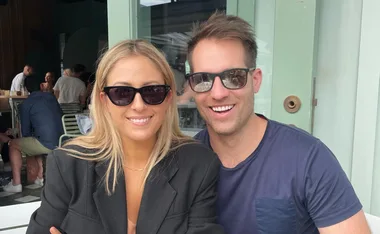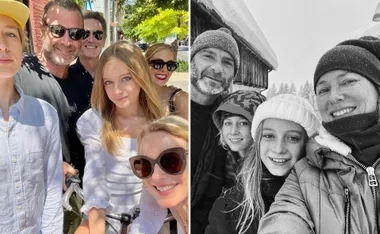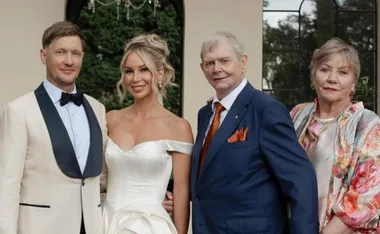The death of a child is a devastating loss. It’s difficult to even begin to think what the death of a child might be like as a parent. You mourn the loss of their life but you also mourn the loss of the potential, their future and their special qualities that made them unique.
As a nation, we watched as West Australian parents Rin Norris and Anthony Maslin said their goodbyes to their three children Mo, Evie, and Otis Maslin, 12, 10 and eight, respectively, who died with their grandfather Nick Norris and hundreds of others when Malaysian Airlines flight MH17 was shot from the skies over Ukraine by Russian-backed separatists on July 17, 2014.
Rin and Anthony’s sorrow was profound, bringing many who watched the televised funeral service to tears. Rin expressed her loss and longing with heart-breaking clarity: “When their innocent bodies were shot out of the sky, I stretched my arms as high as I could and screamed for them,” she said.
“Now I see them only in my head. I can’t touch them. I can’t feel their warmth. My arms will always be reaching for them.”
Rarely has grief appeared so palpable as it did in the eyes of these parents. It brought home to many the distress and emptiness that follows the deaths of children. It’s often said that no parents should ever have to bury their child. Unfortunately, it happens all too often. And when it does, life changes forever for those left behind.
Psychologists agree that the grief that grips a parent after the death of a child is often soul-deep and raw, like an exposed nerve and that the pain that accompanies that loss is so intense that the mind’s natural defence is to retreat into an emotional fog that numbs the senses. For many, that state can last for years but eventually the numbness dissipates and the pain rebounds, as fresh and intense as it was in the beginning.
How does anyone survive such a thing? How does anyone manage to function, let alone find joy in life after standing at your child’s grave side? Is such a thing even possible?
To answer those questions, The Weekly spoke to four mothers who have lost children: Rosie Batty, whose son Luke died in February last year at the hands of his own father, Samantha Hayward, whose 19-day-old baby Ella died in 2009 from a severe viral myocardial infection; Caroline Verity whose three-year-old daughter India died in a tragicly 11 years ago when a metal goal post struck her.
Each has their own answers. Each still carries grief’s indelible mark. And each says that the pain of their loss is still present, years after the event. The truth, for each of them, is that life does go on, but not as it was before; perhaps not with the same happiness or fulfilment, but in an altered form and accompanied by an sense that part of you is missing.
Rosie Batty amazed many with her ability to articulate her feelings and her outspoken views about domestic violence in the wake of her son Luke’s death in February last year.
Luke, a fun-loving 11-year-old, was murdered by his estranged mentally ill father Greg Anderson at a cricket ground in Tyabb, in rural Victoria, a crime that shocked the nation.
The circumstances of her son’s brutal death, which also claimed Greg Anderson’s life after he was shot by police, left Rosie in a state of shock, too. And it was that numbness, she says, that helped protect her in the days, weeks and months that followed.
“With something as horrific as what happened to Luke, I had a complete incapacity to take it in,” says Rosie. In a way your body and your mind stop you taking it in because it is too awful. It’s a kind of natural defence mechanism that keeps reality at bay.
“I was protected by that, more protected than my friends and family. They were completely distraught but I was in a state of emotional numbness. People found it strange that I wasn’t sobbing or weeping uncontrollably. I thought it was strange, too. I fell apart when my cat died but this was my son and I wasn’t devastated or out of control with grief.
“I thought I should be wailing on the floor but I never did that. My coping mechanism has been to keep busy. I took up a campaign against domestic violence and that has taken up a lot of my energy and focus. I found that I needed to find something positive in what happened.”
But that is a two-edged sword, she says. When speaking about domestic violence, something she endured in her fractured relationship with Luke’s father, she found herself touching the reality of Luke’s death.
“It’s a grief that washes over you suddenly as though you’ve been hit from behind by a wave that you didn’t see coming,” she says.
“One moment you are fine and then the next I can feel myself dissolving but then I manage to cope. Usually, when I’m in public, I control it. It’s when I’m alone that it consumes me.
“People often ask how I manage to get out of bed. When I wake up I feel fine. But I know that at some point during the day I will feel the deepest sense of loss and longing. It’s when I am alone that the memories, my thoughts, my feelings come to the surface. All my memories of my son are surrounded in pain.
“How can I look at his clothes? I’ve even kept the first outfit he wore when he came home from the hospital as a baby. How can I look at those things in the future without pain? All the joy, all the special things of life have been taken away from me.
“And yet, when I’m not in those moments I feel like I am the same person I always was – I laugh, I cry, I enjoy food and a glass of wine. I’m the same but my life is different. I try to do the things that make me feel better – I read, I spend time with people I like and who understand me and who support me.
“But the memories are always there, just below the surface. And that is something I have to learn to live with and something, I know, that is going to stay with me for the rest of my life.”
Samantha Hayward has walked this same path for the past five years.
In 2009, her 19-day-old daughter Ella died after contracting viral myocarditis, a condition that causes chronic heart failure.
“I noticed that my daughter was breathing quickly about two weeks after we brought her home from the hospital,” recalls Samantha, 37, a mother of three from southern Sydney.
“I took her to the hospital but when the nurse looked at her she said, ‘Your baby isn’t breathing.’ Ella had stopped breathing on the way to hospital and I hadn’t noticed.”
Doctors rushed Ella into an emergency suite and started to try to resuscitate her. The baby was in cardiac arrest. The room was filled with people desperately trying to help Ella before they administered adrenaline in a final attempt to revive her.
“Then everything stopped,” says Samantha.
“She was dead. I couldn’t believe it. I kept saying ‘No, no.’ I’d come to hospital with my baby. I went home without her.”
The coroner’s report says Ella died of viral myocarditis, brought on by a bout of enterovirus, a highly contagious viral infection that can lead to a variety of severe complications in children.
“Immediately after Ella’s death what I felt was pain, not just an emotional pain but a physical pain as though someone was hammering a nail into my heart. I was silently begging for it to stop. I became very detached at that point. I think I had to or I would have gone insane. I retreated inside myself.”
After trying to wash away her sorrow with wine, Sam realised she needed to talk.
“I called SIDS, the Sudden Infant Death Syndrome group, and I went along to a therapy sessions with other mothers who’d lost their children,” says Sam.
“That’s when things started to get better. Being with women who knew how I felt was an immense comfort. Through them I began to find a way to heal.”
Today, Sam is rebuilding herself.
“The one thing that wasn’t hard was my marriage,” she says.
“My husband Darren was always there. It’s made us stronger and I am grateful for that.”
She’s also grateful for another baby, Ava, now four.
“She’s not Ella,” says Sam.
“Ava is in no way a replacement for Ella. No one could take her place in our hearts. But Ava has helped to heal some of the hurt and given us a new way to love. Ava knows, as we all do, that Ella is with us every day.”
Caroline Verity knows what it is like to live with emptiness in your life.
Caroline’s emptiness is the vacuum left behind after the sudden death of her three-year-old daughter India in 2003.
“It was a chilly winter’s morning and I was at Saturday soccer with India watching our son Joe play with his team,” recalls Caroline.
“She was singing and dancing on the sideline with her friend and then a metal goal post fell over and hit India on the head. She died in the hospital emergency room. That was it. By the end of the day, we didn’t have a daughter anymore.”
Caroline and her husband William, whose older boy, Joe, who was six when India died, were thrown into an emotional maelstrom after India’s death. Both strongly independent, they were grieving in their own ways but not always together.
“We really struggled. That’s the truth of it,” says Caroline.
“We had Joe there with us in the middle of this. Having children helps because you need to focus on them. Joe had had this bomb go off in the middle of his life and we were doing everything we could to make his life OK.
“That is also what kept our marriage together because after India’s death it was hanging by a thread, not once but many times. William and I had different ways of grieving and that caused friction between us.”
William often dealt with his grief internally. He would have his India days, when he sat on the veranda with coffee and a cigarette just to contemplate.
“The worst thing is knowing that your child has died before their time,” says William, a journalist and writer who wrote a book about India’s death, Bear’s Now Asleep, named after the Wiggles song that India was singing before she died.
“When people begin to die out of order, that’s when everything turns to shit.”
By contrast, Caroline found her emotional outlet in tears crying in the car on her way to the supermarket or after she’d dropped her son at school. The result was two people sharing a home and trying to unit for the sake of their son but dealing with their grief alone and taking out their frustration on each other.
“We were really just stumbling along blindly trying to make it all OK for Joe but perhaps forgetting about ourselves and what we each needed,” says Caroline.
“I feel sorry for people that something like this happens and they don’t have small children around. Children live in the moment and they help you to. That is the way through this, when you are surrounded by blackness, to fall back on the clichés – one day at a time, one foot after another. That’s what it is really like.
“I don’t have a prescription or any words of wisdom. It’s just about time. It’s like living through a terrible winter and waiting for spring. Finally that spring came for me and it was a glorious spring because I could enjoy life again.”
Caroline says she has experienced grief before. When she was six, her older sister died. It devastated her family.
“I remember my father telling me that it was like living with a hole in your life that never went away. And that’s true. It never goes away. But it’s also true that you can live with the hole. More than that, you can be happy. You can see the beauty in life. It’s possible. I want people to know that there is light at the end of the tunnel.”
This story originally appeared in an issue of The Australian Women’s Weekly.




.png?resize=380%2C285)





